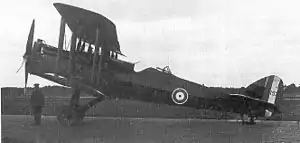de Havilland DH.14 Okapi
The de Havilland DH.14 Okapi was a British two-seat day bomber of the 1910s built by de Havilland. The aircraft was designed as an Airco DH.4 and DH.9 replacement, but it never entered production.
| DH.14 Okapi | |
|---|---|
 | |
| Role | Day bomber |
| National origin | United Kingdom |
| Manufacturer | Airco / de Havilland |
| First flight | 1919 |
| Primary users | Royal Air Force Sidney Cotton |
| Number built | 3 |
Design and development
The Okapi was a scaled-up version of the Airco DH.9 with a bigger engine, (the Rolls Royce Condor) designed as a replacement for the DH.4 and DH.9. Three aircraft were built, but due to the end of the First World War the Royal Air Force was reluctant to accept them. The third aircraft was the first to fly, and it was completed by Airco at Hendon as the DH.14A, a two-seat long-range mail plane. The two military aircraft were completed by de Havilland at Stag Lane Aerodrome in 1921 and used for trials; one suffered a fatal crash at Burnham Beeches on 10 February 1922 and no production aircraft were ordered.
G-EAPY
The third aircraft was completed by Airco as a private venture design, designated the DH.14A. to compete in the Daily Mail transatlantic flight competition.[1] It had a Napier Lion engine and increased fuel capacity (586 gallons).[1] With the winning of the prize by Alcock and Brown the project was abandoned.[1] The aircraft, registered G-EAPY, was then to be used by Sidney Cotton, who intended to try for the Australian government's £10,000 prize for a flight between England and Australia.[1] His plans were overtaken by events when Keith and Ross Smith won the prize before Cotton was ready.[1]
The aircraft was loaned by Airco to Cotton to attempt the first flight between London and Cape Town.[1] Cotton and an engineer from Napier left Hendon on 4 February 1920, it soon forced landed at Cricklewood with oil problems.[1] Cotton reached Naples on the 21 February but they failed to find the aerodrome at Messina where they force-landed on a nearby beach.[1]
G-EAPY was rebuilt by Airco with an additional third cockpit and sold to Cotton for use in the Aerial Derby.[1] The aircraft was badly damaged when it forced landed following an onboard fire near Hertford on 24 July 1920.[1] When the other two DH.14s were completed by De Havilland at Stag Lane in 1921 the DH.14A was repaired again and joined the test flying using a military serial number.[1]
Variants
- DH.14 – two-seat day bomber with a Rolls Royce Condor engine, two built.
- DH.14A – two-seat long range mailplane with a Napier Lion Engine, one built.
Specifications (DH.14)
Data from The British Bomber since 1914[2]
General characteristics
- Crew: 2
- Length: 33 ft 11 1⁄2 in (10.351 m)
- Wingspan: 50 ft 5 in (15.37 m)
- Height: 14 ft 0 in (4.27 m)
- Wing area: 617 sq ft (57.3 m2)
- Empty weight: 4,484 lb (2,034 kg)
- Max takeoff weight: 7,074 lb (3,209 kg)
- Powerplant: 1 × Rolls Royce Condor I water-cooled V12 engine, 525 hp (391 kW)
Performance
- Maximum speed: 122 mph (196 km/h, 106 kn) at 10,000 ft (3,000 m)
- Endurance: 5 hr
- Rate of climb: 400 ft/min (2.0 m/s) [3]
Armament
- Guns:
- 1 × fixed forward-firing synchronised 0.303 in (7.7 mm) Vickers machine gun
- 1 × 0.303 in (7.7 mm) Lewis gun on Scarff ring
- Bombs: 6 × 112 lb (51 kg) bombs in two fuselage bomb bays
References
- Jackson 1987, pp. 148-152
- Mason 1994, p. 123
- Jackson 1987, p. 152
- The Illustrated Encyclopedia of Aircraft (Part Work 1982–1985). Orbis Publishing.
- Jackson, A.J. (1974). British Civil Aircraft since 1919 Volume 2. London: Putnam. ISBN 0-370-10010-7.
- Jackson, A. J. (1987). De Havilland Aircraft since 1909 (Third ed.). London: Putnam. ISBN 0-85177-802-X.
- Mason, Francis K. (1994). The British Bomber since 1914. London: Putnam Aeronautical Books. ISBN 0-85177-861-5.
External links
| Wikimedia Commons has media related to De Havilland DH.14 Okapi. |
- Airco Okapi – British Aircraft Directory